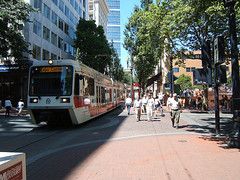Walkability 101-A, by Roger Lewis

Posted May 10, 2010 at 1:35PM
Washington Post columnist and architect Roger Lewis has published a terrific, concise summary of why we should do more to promote walking as a transportation mode and what a community needs to become more walkable. I hope that policy advocates read it.
 Although it has been a long time (late 1990s) since I was a transportation lobbyist per se, I still spend a lot of time around transportation advocates, in part because it is a major focus of NRDC’s current legislative agenda, and in part because transportation and land use are so inextricably intertwined. And although most all, like myself, have consumed the location efficiency Kool-Aid, I generally have a very hard time convincing them that community features like street connectivity and streetscapes that promote walkability are things that they should incorporate into their platforms.
Although it has been a long time (late 1990s) since I was a transportation lobbyist per se, I still spend a lot of time around transportation advocates, in part because it is a major focus of NRDC’s current legislative agenda, and in part because transportation and land use are so inextricably intertwined. And although most all, like myself, have consumed the location efficiency Kool-Aid, I generally have a very hard time convincing them that community features like street connectivity and streetscapes that promote walkability are things that they should incorporate into their platforms.
Maybe it is because, as I was saying in my last post with respect to city parks, it is because so much of my thinking and work is about sustainability at the neighborhood scale, while so much of theirs is about things like carbon reduction targets and the overall structure of massive state and federal programs. The community scale matters, though, and I wish we could have a community transportation title in the next federal transportation law, to fund programs for complete streets, retrofitting places to be more accessible by connecting blocks and neighborhoods to each other, incorporating green infrastructure into transportation facilities, community planning, and pedestrian and bicycling infrastructure. It could be modeled on the highly successful and popular Transportation Enhancements Program in current law, which already funds a limited menu of community-oriented projects.
 Such a program would improve our access to recreation, education, goods and services while reducing our need to drive as often or as far as we do now. And, not coincidentally, it would promote public health, help restore watersheds, and improve our quality of life. Just because the benefits can’t always be measured in carbon molecules doesn’t mean they aren’t important, or that the federal government shouldn’t be a partner with states, regions and municipalities in promoting them.
Such a program would improve our access to recreation, education, goods and services while reducing our need to drive as often or as far as we do now. And, not coincidentally, it would promote public health, help restore watersheds, and improve our quality of life. Just because the benefits can’t always be measured in carbon molecules doesn’t mean they aren’t important, or that the federal government shouldn’t be a partner with states, regions and municipalities in promoting them.
Back to Roger's column, he believes that, by focusing so intently on transit-oriented development, we may be overlooking what may be the most sustainable form of transportation of all. His column (“Terms, mind-sets must be changed to encourage and enable more walking in cities”) is only 14 paragraphs long, but every one contains a gem. Some samples:
- “Street patterns must be easily navigable and latticelike, with blocks that are not too big and intersections that are not too far apart.”
- “A thoughtful mix of shade trees and vegetation beautifies streetscapes and makes them ecologically greener.”
- “It must be safe to walk, day or night.”
- “Because there is safety in numbers, streets lined by eateries with outdoor seating are even safer, not to mention livelier. People will walk along such streets because walking is delightful.”
- “Look at cities such as New York, Boston, San Francisco, London, Paris and Barcelona. These cities have beautiful streets that encourage walking. Commuters in these cities happily walk 15 or 20 minutes from a subway or rail station, or from a parking garage, to their home, workplace or school.”
The “neighborhood pattern and design” section of LEED for Neighborhood Development places a strong emphasis on the quality of the streetscape, because of its importance to both walkability and community.  We will find out in implementation how much of it we got right, but Roger’s column makes me optimistic.
We will find out in implementation how much of it we got right, but Roger’s column makes me optimistic.
One more personal note before I sign off for today: Not long ago I had a friendly give-and-take with a colleague whose opening position was that design should not be relevant to policy. To be fair, I think he was implicitly referring more to architectural building style than to the design of a community, and if so he had a point; but I tried to persuade him that, in fact, neighborhood design matters tremendously to sustainability and environmental quality. While I would heartedly agree that we should take care not to be overly prescriptive in policy, my position is that advocates need to know something about design in order to have a better understanding of which policy instruments will be most successful in achieving their goals. I don’t think I convinced him, exactly, but I hope I gave him something to consider.
Roger’s column helps my case, and you can read it here.
Move your cursor over the images for credit information. Next: Walkability 101-B, or why it's good to be connected.